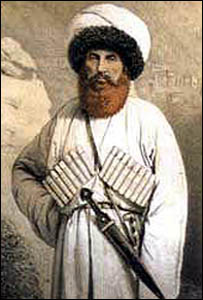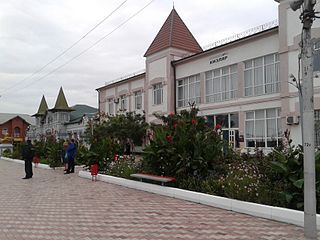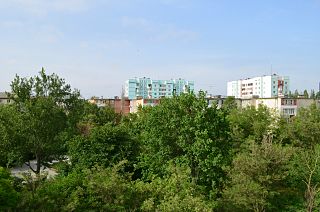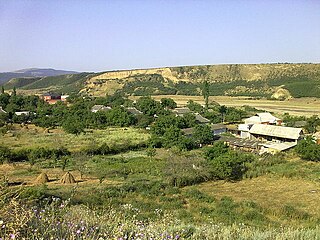
The Avars, also known as Maharuls, are a Northeast Caucasian ethnic group. The Avars are the largest of several ethnic groups living in the Russian republic of Dagestan. The Avars reside in the North Caucasus between the Black Sea and the Caspian Sea. Alongside other ethnic groups in the North Caucasus region, the Avars live in ancient villages located approximately 2,000 meters above sea level. The Avar language spoken by the Caucasian Avars belongs to the family of Northeast Caucasian languages. Sunni Islam has been the prevailing religion of the Avars since the 13th century.

Dagestan, officially the Republic of Dagestan, is a republic of Russia situated in the North Caucasus of Eastern Europe, along the Caspian Sea. It is located north of the Greater Caucasus, and is a part of the North Caucasian Federal District. The republic is the southernmost tip of Russia, sharing land borders with the countries of Azerbaijan and Georgia to the south and southwest, the Russian republics of Chechnya and Kalmykia to the west and north, and with Stavropol Krai to the northwest. Makhachkala is the republic's capital and largest city; other major cities are Derbent, Kizlyar, Izberbash, Kaspiysk, and Buynaksk.

Kizlyar is a town in the Republic of Dagestan, Russia, located on the border with the Chechen Republic in the delta of the Terek River 221 kilometers (137 mi) northwest of Makhachkala, the capital of the republic. As of the 2010 Census, its population was 48,984.

The peoples of the Caucasus, or Caucasians, are a diverse group comprising more than 50 ethnic groups throughout the Caucasus.
Tindi is a Northeast Caucasian language spoken in the Russian republic of Dagestan. Tindis call their language Idarab mitstsi meaning 'the language of the Idar village'. It is only an oral language; Avar or Russian are used in written communication instead. Tindi vocabulary contains many loanwords from Avar, Turkish, Arabic, and Russian. It has approximately 2,150 speakers.

The Archi people are an ethnic group who live in eight villages in Southern Dagestan, Russia. Archib is the 'parent village' of these, because three months a year the whole community used to reassemble in Archi to engage in communal work. Their culture is one of the most distinct and best-preserved of all the cultures of Dagestan.

The Dagestan Autonomous Soviet Socialist Republic (1921–1991), abbreviated as Dagestan ASSR or DASSR and also unofficially known as Soviet Dagestan or just simply Dagestan, was an autonomous republic of the Russian SFSR within the Soviet Union. This "Land of Mountains" was known also for having a "mountain of peoples," with more than thirty ethnic groups indigenous to the territory. This region was absorbed in to the Russian empire in 1813 after the signing of the Gulistan Peace Treaty, and subsequently became a breeding ground for early revolutionary fervor in the Russian Revolution due its people's discontent with being part of the empire.
Azerbaijanis in Russia or Russian Azerbaijanis are people of Azeri descent in Russia. These may be either ethnic Azeris residents in the country or recent immigrants who profess Azeri ancestry.

Kizilyurt is a town in the Republic of Dagestan, Russia, about 53 kilometers (33 mi) northwest of Makhachkala. Population: 32,988 (2010 Census); 30,264 (2002 Census); 33,682 (1989 Census). It is located where the north-flowing Sulak River leaves the mountains and enters the Terek-Sulak Lowland.
The Andis are one of the indigenous Dagestan peoples of North Caucasia. Their territory is included in the Botlikhsky District (raion) of Dagestan. The Andis are Sunni muslims.

The Tsez are a North Caucasian ethnic group. Their unwritten language, also called Tsez or Dido, belongs to the Northeast Caucasian group with some 15,354 speakers. For demographic purposes, today they are classified with the Avars with whom the Tsez share a religion, Sunni Islam, and some cultural traits. They are centered at the Tsunta district of the Republic of Dagestan, Russia. The term “Dido” is sometimes used in a broader sense to refer to the Tsez as well as the Bezhtas, Hinukhs, Khwarshis and Hunzibs, which are also categorized as Avar subgroups. According to the 2002 Russian census, there were 15,256 self-identified Tsez in Russia, notated as an "Avar subgroup", though the real number is probably slightly greater.
The Akhvakhs are one of the Andi–Dido peoples of Dagestan and have their own language. They call themselves Atluatii or Ashvado. Prior to 1930 Soviet ethnologists considered them to be a distinct ethnic group. Since that time they have often been classified as Avars.
The Botlikh people are an Andi–Dido people of Dagestan. Until the 1930s they were considered a distinct people. Since that time they have been classified as Caucasian Avars and have faced a campaign to have them assimilate into that population. The Botlikh are primarily Sunni Muslims. They adopted the religion by the 16th century due to the influence of Sufi missionaries.
The Hinukh are a people of Dagestan living in 2 villages: Genukh, Tsuntinsky District - their 'parent village' and Novomonastyrskoe, Kizlyarsky District - where they settled later and live together with Avars and Dargins and also in the cities of Dagestan. They are being assimilated by the Caucasian Avars.
The Bezhta are an Andi–Dido people living in the Tsuntinsky region in southwestern Dagestan. In the 1930s along with the rest of the Andi-Dido peoples they were classified as Avars. However, some people identified themselves as Bezhta in the 2002 census of Russia. They speak the Bezhta language, but many of them also speak Avar, Russian or other Tsezic languages of their region. They numbered 1,448 in 1926. According to the Russian census in 2002, there were 6184 self-identified "Bezhtins", though the real number is probably higher.
The Bagvalal language (Bagulal) is an Avar–Andic language spoken by the Bagvalals in southwestern Dagestan, Russia, along the right bank of the river Andi-Koisu and the surrounding hills, near the Georgian border. It is fairly similar to Tindi, its closest relative. The 2010 Russian census recorded 1,450 Bagvalal speakers.

Novolaksky District is an administrative and municipal district (raion), one of the forty-one in the Republic of Dagestan, Russia. It is located in the west of the republic and borders with Khasavyurtovsky District in the northeast, Kazbekovsky District in the southeast, and with the Chechen Republic in the west. The area of the district is 218.2 square kilometers (84.2 sq mi). Its administrative center is the rural locality of Novolakskoye. As of the 2010 Census, the total population of the district was 28,556, with the population of Novolakskoye accounting for 20.8% of that number.
The Karata or Khkhiridi people are a small ethnic group from Dagestan, North Caucasus. The Karata mainly reside in the Akhvakh and Khasavyurt district. They primarily speak the Karata language.
The Chamalals are an indigenous people of Dagestan, North Caucasia living in a few villages in the Tsumadinsky District on the left bank of the Andi-Koysu river. They have their own language, Chamalal, and primarily follow Sunni Islam, which reached the Chamalal people around the 8th or 9th century. There are about 5,000 ethnic Chamalals. They are culturally similar to the Avars.
The Hunzibs are an indigenous people of Dagestan, North Caucasus living in three villages in the Tsuntinsky District in the upper regions of the Avar-Koysu river area. They have their own language, Hunzib, and primarily follow Sunni Islam, which spread among the Hunzib people around the 8th or 9th century. Islam became consolidated among the Hunzib around the 16th and 17th centuries. The land where the Hunzibs inhabit was part of the Avar Khanate. The only time that the Hunzibs were counted as a distinct ethnic group in the Russian Census was in 1926, when 105 people reported to be ethnic Hunzibs. Subsequently, they were listed as Avars in the Russian Censuses. In 1967, it was estimated that there were about 600 ethnic Hunzibs.









